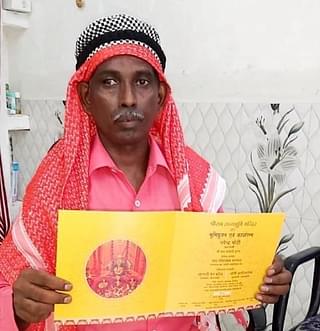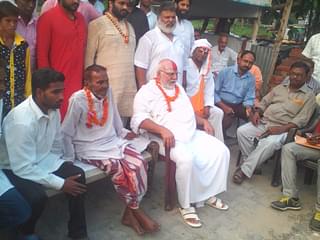
[ad_1]
When I ask residents about Iqbal Ansari, I am directed to a man casually standing at a small tea stall. Dressed in a white shirt, gray trousers, a brown half-jacket, and a vibrant cap, Ansari blends seamlessly with the local populace.
On greeting him and introducing myself, he points towards the tea seller, a Hindu woman, and remarks, “She belongs to your biradari (community). I always take tea from her. You might know me as the Babri petitioner, but first and foremost, I’m Ayodhyawasi (a resident of Ayodhya). Here, Hindu-Muslim distinctions don’t exist.”
Moments later, Ramkishen Suman, a local, joins our conversation, affectionately referring to Ansari as “Netaji.” Explaining this honorific, Suman says that Ansari, like his father, is respected by all locals as he leverages his administrative connections to resolve community issues.
“If we have an issue, where else do we go? We go to Netaji,” he says.
A short walk from the tea stall leads to Ansari’s home in Mohalla Kotiya Panji Tola. Right opposite the house, there’s a tyre repair shop, where four to five armed jawans are standing guard.
This shop is managed by Ansari’s son.
At this shop is a photograph of Ansari’s father on which is written ‘Muddai Babri Masjid, Haji Mohammed Hashim Ansari’, where ‘Muddai’ means petitioner, and ‘Haji’ denotes one who has completed the Hajj.
Ansari’s father, who undertook the Hajj at 75, passed away in 2016, at the age of 96.
Ansari himself has yet to undertake the pilgrimage. “It’s too expensive,” he says.
Following his father’s demise, he took over the lawsuit initially filed in 1952 challenging the Hindu claim of ownership of the site. The nameplate outside Ansari’s house reads ‘muddai Iqbal Ansari.’
Iqbal Ansari


Iqbal Ansari (left) and his neighbour Ramkishen Suman


Ansari walking to his house from the tea stall
The tyre repair shop in front of Ansari’s house
Ansari standing at the gate of his house


The room at the entrance reserved for guests
A picture of Ansari’s father Hashim, who was original petitioner


A picture from 2020 where Ansari is showing the Bhumi Pujan invitation to the media
After the 2019 Supreme Court verdict favouring the Hindu side in the long-standing Ram Janmabhoomi-Babri structure dispute, Ansari told the media that he accepted and welcomed the verdict. “We had said that we will accept whatever the court decides even before the judgment came. We now welcome the verdict,” he stated.
When the All India Muslim Personal Law Board made an immediate announcement of filing a review petition against the apex court decision, Ansari distanced himself from it. “There is no use of going for the review as the outcome will remain the same…the move will also vitiate the harmonious atmosphere,” he told the media.
Ansari also graciously accepted the invitation to the Ram temple bhoomi pujan on August 5, 2020. He was the first to receive an invitation card for the ceremony. He told the press, ” I believe it was Lord Ram’s wish that I receive the first invitation.”
Ansari now refrains from discussing the centuries-old dispute, considering it resolved. He says his family has never viewed their involvement in the case as opposition to Hindus.
He fondly recalls how his father and Mahant Ramchandra Paramhans of the Digamber akhara, a Hindu litigant seeking permission to conduct puja of Ram Lalla inside the mosque, would go in the same rickshaw for court hearings.
He says he shares a similar camaraderie with Mahant Suresh Das, who succeeded Paramhans in the case after his demise in 2003 at the age of 90.
His father was a tailor by trade. According to Ansari, his family commands respect among Ayodhya’s Muslim community as his grandfather, Karim Baksh, served as a diwan in the Kanak Bhawan estate, a prestigious position.
Ansari says it was due to this stature that his father was unanimously chosen to represent the Muslim community in a counter lawsuit against the Hindu side filed in 1961 by the Sunni Central Waqf Board.
In a slightly different version provided by residents, Hashim’s protests against the installation of an image of Lord Ram in the Babri structure in 1949, earned him the position of litigant.
On the morning the image “appeared” under the central dome of the structure – 23 December, 1949 – Hashim climbed up a tree and jumped into the compound of the ‘mosque’, locals say.
On another occasion, he gave a call for namaz (azaan) at the disputed site. In 1952, he was sentenced to jail for two years by a Faizabad court for breach of peace.
Ansari says his father never experienced hostility from Hindus for his role in the case until 1990 when “outsiders” began entering Ayodhya.
On December 6, 1992 – the day ‘karsevaks’ from across the country gathered in Ayodhya on the call of Vishwa Hindu Parishad (VHP) and demolished the Babri structure – Ansari’s house was set ablaze.
He remembers, “It was around noon. Karsevaks had already brought down the mosque. We were warned of escalating violence and told to promptly leave.”
The Ansari family hastily relocated to a relative’s home five kilometers away. Within an hour, most Muslim families in Kotiya Panji Tola evacuated.
Asked if he locked the house before leaving, Ansari responds with a wry smile, “Locking the house was seen as impolite to neighbours then. We didn’t even own locks.”
“There wasn’t much of value in the house anyway,” he adds.
Ansari says a mob, seeking the ‘muddai‘, burnt his house. They went on to torch several other Muslim houses in the neighbourhood.
Nearby residents Kishan Lal Sonkar and his wife Sudama, who live nearby, point towards three Muslim houses opposite theirs that were set on fire. “We attempted to douse the flames with water, but the fire raged on,” Sonkar says.
A picture of Babri mosque in the room


An old picture showing late Mahant Bhaskar Das (left) with late Hashim Ansari


Late Hashim Ansari with Mahant Gyan Das (in white) of Hanuman Garhi temple


Mahant Satyendra Das, pujari of Ramjanmabhoomi temple, and Iqbal Ansari
Kishan Lal Sonkar and Sudama
The Muslim families, including the Ansaris, returned after a month. They had heard about the devastation. With government aid and community support, they rebuilt their homes.
Reflecting on the past, Ansari expresses no bitterness, and says, “It’s all in the past now. Let’s hope the verdict and construction of the mosque paves way for permanent peace in Ayodhya.”
Until the Supreme Court’s decision, each December 6 witnessed gatherings at his home, where attendees, including lawyers representing the Muslim side, wore black arm bands. Ansari provided modest hospitality, making arrangement for tea and water.
Mediapersons would come and record statements from Ansari and others. The Muslims called it their ‘Yaum-e-Gham’ (day of sorrow) or simply ‘Gham Diwas’.
This yearly ritual of three decades, which is said to have started on the call of All India Muslim Personal Law Board, has since ceased. It stopped after the Supreme Court verdict in 2019.
The same day, on VHP’s call, Sangh workers and Hindu residents of Ayodhya had been observing ‘Shaurya Diwas’ (day of valour), before that ritual too ended in 2019. “There is no need for that anymore,” a VHP worker said.
Residents would light diyas and keep it outside their houses, and some temples would hold special puja or paath.
Post-1992, Ansari has been under police protection. In 2019, a month before the Supreme Court’s verdict, a man and a woman barged into his house and pressured him to withdraw the case. Ansari regards this episode as a bygone matter, and declines to elaborate.
His house gets frequent visitors – “sometimes a hundred people a day” – particularly from the news media. “Media hamari rishtedaar hai (Media is my relative),” he says.
The room at the house’s entrance is reserved for guests.
It’s a modest room (see pictures above), displaying awards and recognitions acknowledging the father-son duo’s role in pushing the Muslim cause in the dispute. Among these is a portrait of Hashim Ansari, with a picture of Babri structure painted in white in the backdrop.
There is also a shield titled ‘Aman ke farishtey’ (angels of peace). It’s a token from ‘Ansar sabha,’ an association of the caste to which Ansari belongs.
Ansari belongs to the ‘julaha’ caste of the Muslim community, where julaha is a derivative of a Persian word for weaving. Julahas, traditionally weavers, are among the largest caste groups among Indian Muslims.
It comes under the backward class category in several states including Uttar Pradesh. The corresponding Hindu weaver community is notified as a Scheduled Caste in several states.
Ansari says he maintains a distance from politics and radical groups, and seeks communal harmony. He says he has never solicited community funds for his legal battle.
He participates in Hindu religious events when invited and accepts prasad. He awaits an invitation to the inauguration of the Ram temple on 22 January.
Save & read from anywhere!
Bookmark stories for easy access on any device or the Swarajya app.
[ad_2]